Last updated: April 18, 2024
Article
Orchard Project at Martin Van Buren National Historic Site

NPS
In the first week of April 2024, park staff from Martin Van Buren National Historic Site, Roosevelt-Vanderbilt National Historic Site, and the Olmsted Center for Landscape Preservation worked with volunteers to plant 81 apple and pear trees in the three acre north orchard at Martin Van Buren National Historic Site. The planting marks the culmination of many years of planning and preparation to rehabilitate the historic orchard. It is also an excellent example of collaboration between the National Park Service and the Tribal Historic Preservation Office during the project’s design and compliance process. By next spring, when the planting is complete, 136 fruit trees will grow in the orchard.
Landscape History
Martin Van Buren purchased the Lindenwald estate in eastern New York while serving as the eighth president of the United States. After completing his presidential term in 1841, Van Buren moved to the property where he remained active in national politics and engaged in progressive agriculture as an extension of his political beliefs. Attempting to prevent the expansion of slavery into the western territories, Van Buren used farming to demonstrate that soil in the northern states was not “spent” and could be worked economically without enslaved labor. Though his 1848 bid for the presidency as a third party candidate of the Free Soil Party was unsuccessful, Van Buren continued promoting and practicing progressive farming throughout his life.
Orchards have a long history at Lindenwald. Early in Van Buren’s tenure at the property, his employees planted several thousand apple and pear trees in orchards to the northwest and southwest of the mansion where Van Buren lived. Evidence of the north orchard survives in estate records like a 1841 sketch map and July 1843 deed. The orchard trees are also referred to in correspondence, including a suggestion that Van Buren may have propagated and sold fruit trees at a fairly large scale.

NPS/Martin Van Buren National Historic Site. Original is part of Van Buren Papers, Pennsylvania State University.
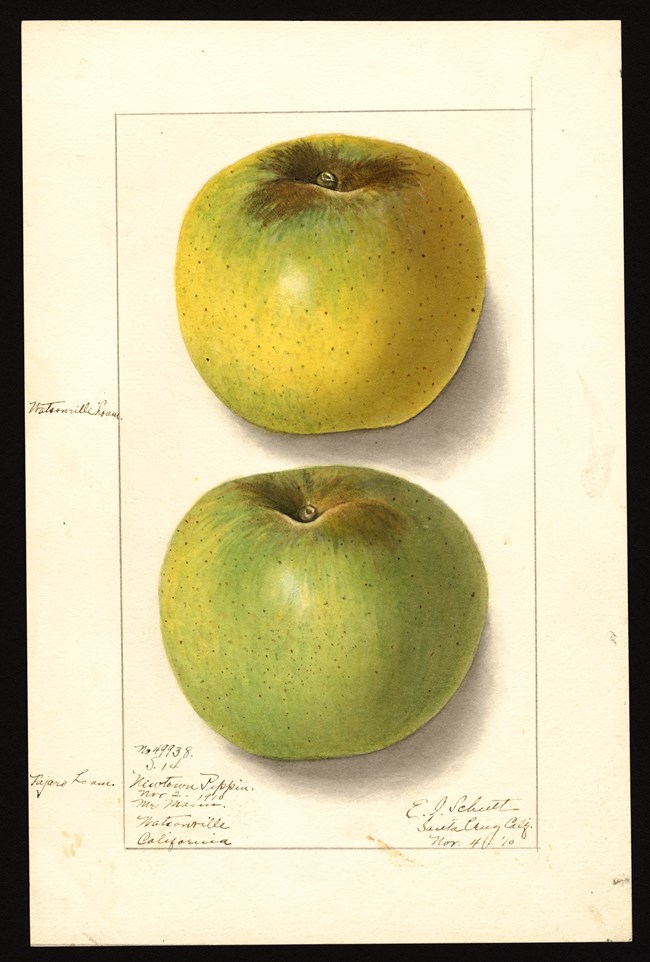
Ellen Isham Schutt, USDA Pomological Watercolor Collection
The exact composition of the orchard is not known today. Given his connections to urban markets and his interest in horticulture, it is probable that Van Buren grew some of the more popular, commercially-grown apple varieties of the time, such as Newtown Pippin and Esopus Spitzenburg, which were among the first apples sold in New York City, or Baldwins. Pears may have included Seckel, an American variety developed near Philadelphia, and other varieties imported from Germany.
Planning for Landscape Rehabilitation
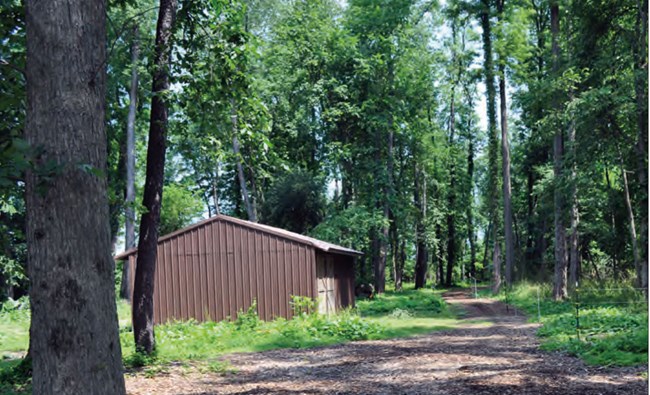
NPS / OCLP
The orchards remained intact until the mid-1900s, when successional woodland growth gradually overtook the northern orchard.
Martin Van Buren National Historic Site was established in 1974. Beginning in the 1990s, the Olmsted Center for Landscape Preservation has worked with the park to provide landscape management guidance. A 1997 Cultural Landscape Report for the park recommended re-establishing the north orchard as part of a holistic cultural landscape treatment plan. This work, also recommended in the 2016 Cultural Landscape Report Volume II: Updated Treatment Plan and Record of Treatment, was put on hold for almost 25 years. In 2019, the park reinitiated interest in orchard rehabilitation and sought funding for the project.


Left image
Period Plan: 1839-1864
Credit: NPS / OCLP
Right image
Landscape Conditions: 2016
Credit: NPS / OCLP
A multi-disciplinary team assembled. Two primary concerns guided project decision-making: protection of archeolocigal resources and sustainable orchard management. The park has built a strong working relationship with the Tribal Historic Preservation Program of the Stockbridge-Munsee Band of Mohican Indians, a tribal government whose traditional homeland includes the Hudson River Valley. Before planning started, the park worked closely with the Mohican Tribal Historic Preservation Officer (THPO) to understand the tribe’s perspectives on soil disturbance and artifact collection and ensure that orchard development did not impact artifacts related to their cultural heritage.
From Plan to Planting
The goal of the project was to plant, with limited ground disturbance, a sustainable, historically authentic orchard that met Martin Van Buren National Historic Site’s interpretation and management goals. The plan addressed orchard management, resource sensitivity and preservation, and environmental sustainability.
The design factors included orchard location, fencing, tree spacing and arrangement, orchard design (tree spacing and arrangement), variety and rootstock selection, and planting techniques to restore the historic landscape character through the introduction of a historically authentic and environmentally sustainable orchard to better evoke Van Buren’s progressive farming legacy.
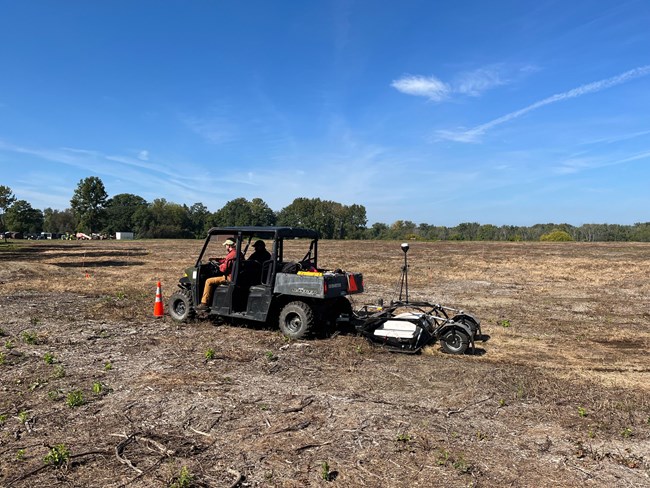
NPS
While the newly planted orchard is not an exact replica of Van Buren’s orchard, since replanting Van Buren’s 2000 trees in a changing climate would not be sustainable, the orchard replicates Van Buren’s zeal for employing the most relevant agricultural practices of the time.
Fruit trees in the new orchard are spaced in a thirty-foot grid pattern which mimics Van Buren’s tree layout. The design team adjusted the number of trees, size and shape of the orchard, and arrangement of tree varieties were of the field and number and arrangement of tree varieties to protect archeological resources and follow contemporary organic orchard management practices. While the exact apple and pear cultivars grown in the orchard during Van Buren’s time are unknown, the park selected cultivars representative of the range of varieties grown in the mid-1800s in the Hudson River Valley, with some exceptions to provide a continuous harvest.

NPS
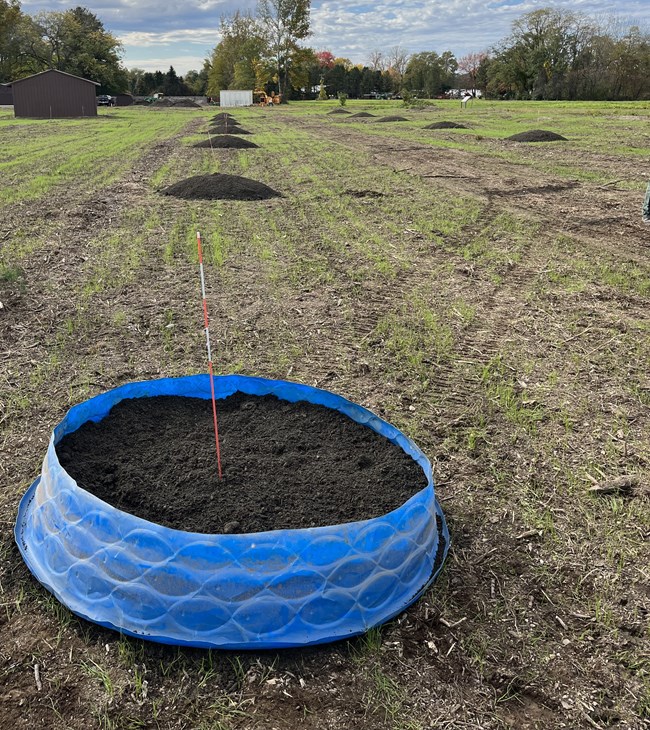
NPS
In 2022, as part of the creation of the Martin Van Buren National Historic Site Orchard Rehabilitation Plan, orchard design alternatives and an implementation strategy were developed through meetings with stakeholders, site visits, and expert interviews. The park met with local orchardists to develop a successful strategy for planting an orchard with little or no ground disturbance. Farmscape Ecology, a local research and education program, connected the park with two experienced local orchardists. The orchardists at Threshold Farm in Philmont, New York suggested the park use hügelkultur, a historic technique of planting in mounds, to avoid soil disturbance.
Local orchard expert Mike Biltonen, of Know Your Roots, was hired as a consultant to guide the team through this unusual planting process. Planning meetings brought together staff of Martin Van Buren National Historic Site including Superintendent Megan O’Malley, Facility Manager Michael Orapello, and Archeologist Jared Muehlbauer; staff of the Olmsted Center for Landscape Preservation including Historic Landscape Architect Jennifer Hanna and Horticulturist Brooke Derr; the Northeast Archeological Resources Program; and local orchardists.
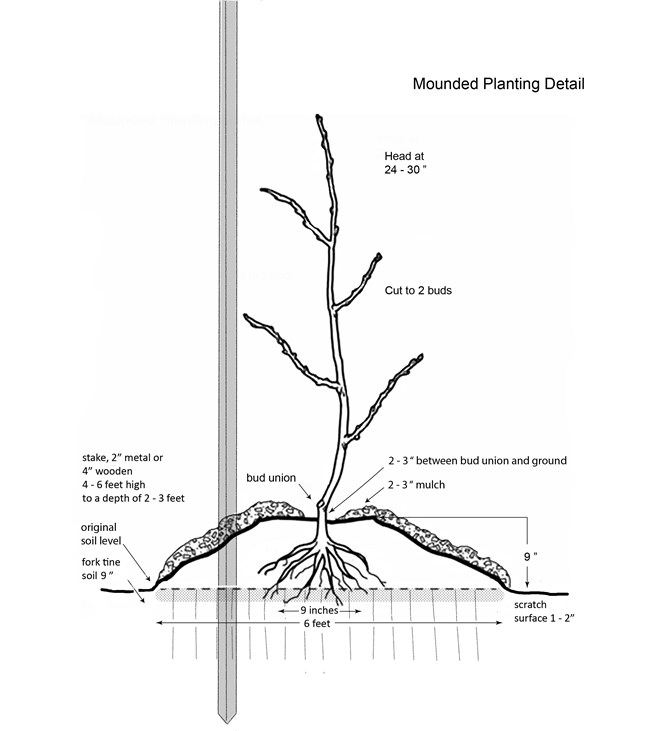
NPS / OCLP
One of the most challenging aspects of the project was designing planting specifications that would minimize soils disturbance to less than two inches, following recommendations of the consultation process and archeologists. In the resulting design plan, young trees are planted into mounds and staked for support. This is a highly unusual practice and will be monitored as an experimental design.
Deer fencing, now a necessary component of orchard maintenance, was selected to minimize visual intrusion, and post location was determined using GIS and archeology layers to avoid areas of sensitivity. Likewise, the irrigation system was designed to minimize soil disturbance and avoid interference with sensitive areas.
The success of this project represents the dedication and flexibility of park and regional staff that worked toward a creative solution for rehabilitating the orchard at Martin Van Buren National Historic Site. The park hopes that the fruit trees will offer more opportunities for visitor and volunteer engagement with the agricultural history of the site.

NPS
Project Details
Schedule
-
Removed trees from woodlot on orchard site.
-
Ground tree stumps.
-
Mowed brambles.
-
Sprayed herbicide to clear area for new orchard.
-
Installed orchard fence.
-
Removed remaining vegetation and stump debris using a York Rake attachment.
-
Loosened the top two inches of soil surface using a lightweight tiller.
-
Aerated fields (as an alternative to deeper tillage to protect potential archeological resources).
-
Planted cover crop.
-
Created soil mounds, using a round plastic wading pool with the bottom cut out.
-
Allowed soil mounds to settle.
-
Planted 81 apple and pear trees.

NPS



